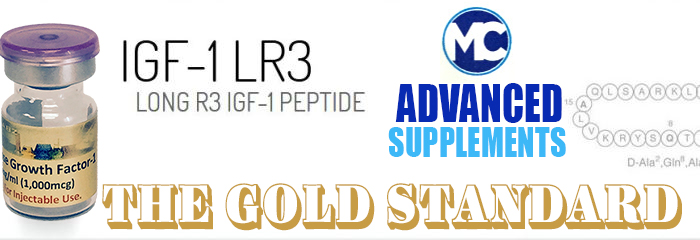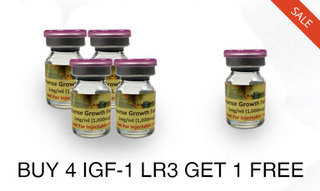Stimulate Muscle Growth and Promote Protein Anabolism With IGF-1 lr3
Stimulate Muscle Growth and Promote Protein Anabolism With IGF-1 lr3. When it comes to its effect on the body, IGF-1 shares many of the same traits as human growth hormone (HGH). This is to be expected; HGH is in fact a precursor to IGF-1, signalling for its release when the HGH binds to its receptors. It’s the IGF-1 that stimulates muscle growth and promotes protein anabolism.
IGF-1 is highly anabolic and will promote both muscle hypertrophy (growth) and hyperplasia (formation of new
muscle cells). While the level of muscle growth from IGF-1 use is likely to be less than that of most anabolic androgenic steroids, the hyperplastic effects of IGF-1 is highly desirable and cannot be achieved from steroids which merely hypertrophies the existing muscle tissue.
In addition and of particular interest to athletes, IGF-1 has a positive effect on connective tissue and cartilage repair making it a superb compound to run during rehab and heavy training phases within the year.
Unlike HGH, IGF-1 doesn’t appear to directly cause heightened fat mobilisation. This is interesting because many users of the hormone do note its apparent ability to reduce or maintain body fat levels during periods of high calorie consumption, yet this is likely down to the insulin-like effect of IGF-1 which promotes a state of lower blood sugar. This is important to note and is covered later when we discuss side effects.
Stimulate Muscle Growth and Promote Protein Anabolism With IGF-1 lr3
The difference between IGF-1 LR3 and IGF-1 DES
When most people talk of IGF-1 they are in fact usually talking about the popular IGF-1 LR3 variation.
Having a very short half-life (< 10 minutes) and being acutely unstable, IGF-1 in its base form is not commonly used by bodybuilders or athletes. The two popular variations, IGF-1 LR3 and IGF-1 DES, are both modifications of the base protein and possess superior qualities for use; less sensitive, more potent and a longer half-life.
IGF-1 LR3 – while IGF-1 in its base form has a half-life of less than ten minutes, IGF-1 LR3 has a half-life of a day. With such an extended half-life the hormone has a far greater timeframe to circulate around the body, bind to receptors and exert its effects.
With IGF-1 LR3 it is neither necessary nor effective to perform site specific injections as the hormone will have ample opportunity to propagate from the injection site given its half-life.
IGF-1 DES – being the shorter, more potent variation available, IGF-1 DES has a half-life of around thirty minutes and is far more unstable than that of LR3.
Site specific injections using IGF-1 DES can be particularly effective and worthwhile, with bodybuilders typically injecting the muscle group they are about train pre-workout. The theory behind this is sound; high lactic acid build up causes the IGF-1 receptors to be more accepting, therefore injecting into a muscle group that is about to be trained should provide the best results.
Pre-workout site injections are taking advantage of the inbuilt biological response which naturally occurs during a workout – lactic acid builds up in the muscle being work, signalling for the release of HGH and IGF-1 to help repair the micro-traumatised muscle tissue. The body is smart and the IGF-1 ends up where it’s needed; binding to the receptors which have been deformed by the lactic acid.
Cycles, doses and results
The first thing that must be said is that IGF-1 is an advanced hormone and should only be considered by those with several AAS cycles under their belt.
IGF-1 will NOT produce the sort of muscle mass or strength gains experienced from using steroids. If you’re looking to get the most bang-for-your-buck, try a Dianabol or testosterone cycle instead. IGF-1 does however provide several unique qualities which are highly prized by many advanced bodybuilders and athletes.
As mentioned, IGF-1 can do something which no steroid can – increase the actual number of muscle cells you possess via hyperplasia. No longer are trainers limited by their genetics; IGF-1 ‘levels-up’ the athlete’s potential by increasing the number of muscle cells which can be further hypertrophied through training and steroid cycles.
For athletes, IGF-1 provides a hard to detect hormone that unmistakeably aids performance, reduces recovery time and pushes the envelope for those who are already at the limits of their genetic potential.
A good starting point for dosing IGF-1 LR3 would be 40mcg per day. Strangely (and unwisely in my view) it is isn’t uncommon to see a daily dose of ~100mcg recommended by other online resources, yet in my experience this sort of dose is totally unnecessary and I wouldn’t recommend a dose higher than 100mcg for even the most advanced trainers with considerable IGF-1 experience.
IGF-1 LR3 should be injected intramuscularly and given its longer half-life it’s not necessary to site inject, although many trainers do choose to inject post workout into the muscle group they’ve just trained.
A typical IGF-1 cycle will last four weeks and will yield the best results when stacked with anabolic androgenic steroids which amplify its effects. The thing to remember with IGF-1 is you’re unlikely to see specular results; it’s the cherry on the cake for advanced trainers who are happy to see half a pound to a pound of quality muscle gained per week and expectation of long-term benefits.
Another popular and effective use of IGF-1 is as a bridge into PCT. When a trainer ceases a steroid cycle their natural testosterone production is usually significantly suppressed – a catabolic state that should be rectified as quickly as possible from following a proper PCT protocol. By timing the IGF-1 cycle to start a week before the end of a steroid cycle we can provide anabolic cover during PCT and it isn’t unusual for trainers to continue to see decent gains during their PCT when following this protocol.
When administering IGF-1 DES the doses used are fairly similar, with 20-40mcg per day a wise starting point. Because IGF-1 DES is usually injected pre workout into the target muscle group it is common to split the dose so both sides of the body receive an equal amount, e.g. 20mcg into the left bicep and 20mcg into the right.
Stimulate Muscle Growth and Promote Protein Anabolism With IGF-1 lr3
Side effects to watch out for
IGF-1 is a powerful hormone and should be respected.
Accelerated tumour growth, heightened risk of cancer and enlargement of internal organs are all potential side effects of IGF-1 use. While I do not encourage anyone to take illicit substances (including IGF-1) it would seem particularly unwise to abuse IGF-1 if you, or close family members, have a history of cancer.
IGF-1 behaves in a similar way to that of insulin and its use tends to lead toward a hypoglycaemic state. This is something that everyone should take note of, but especially so for those who use/abuse insulin and are planning to use IGF-1 at the same time.
Headaches (sometimes severe) and nausea are a fairly common imminent side effect reported when using IGF-1 and appear to be dose dependant.
Read Thousands Of IGF-1 lr3 Customer Reviews
Reviews, Studies & Everything You Ever Wanted To Know About IGF-1 Lr3 Can Be Found Here


